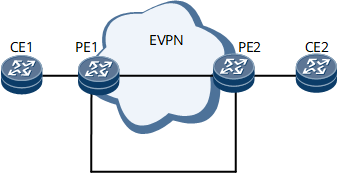Configuring MAC Duplication Suppression for EVPN
When PEs are interconnected both through network-side and access-side links, MAC route flapping may occur. To resolve this issue, you can configure MAC duplication suppression.
Usage Scenario
On the EVPN E-LAN shown in Figure 1, the two PEs may be interconnected both through network-side and access-side links. If this is the case, a BUM traffic loop and MAC route flapping both occur, preventing devices from working properly. By default, MAC duplication suppression is enabled on a device. Also by default, the system checks the number of times a MAC entry flaps within a detection period. If the number of MAC flaps exceeds the upper threshold, the system considers MAC route flapping to be occurring on the network and consequently suppresses the flapping MAC routes. The suppressed MAC routes cannot be sent to a remote PE through a BGP EVPN peer relationship.
If you want to modify parameter configurations related to MAC duplication suppression, perform the following procedure.
Pre-configuration Tasks
Before configuring MAC duplication suppression, Configuring BD-EVPN Functions or Configuring Common EVPN Functions must have been performed on the network.
Procedure
- Configure MAC duplication suppression for all EVPN instances.
- Configure MAC duplication suppression for a specified EVPN instance.
Follow-up Procedure
When a MAC route to a specific MAC address or MAC routes in a specific BD have stopped flapping and you want to restore them before the configured hold-off timer expires, run the reset evpn vpn-instance vpn-instance-name mac-duplication [ bridge-domain bd-id ] [ mac-address mac-address ] command in the user view. This allows you to manually clear the suppression state of the MAC routes.
Under certain conditions, a MAC route is unsuppressed automatically. For this to take place, a static MAC address must be configured or an EVPN instance must receive a MAC address that carries the static flag. The MAC address must be the same as that of the suppressed MAC route.
Verifying the Configuration of MAC Duplication Suppression
Run the display evpn vpn-instance name vpn-instance-name mac-duplication [ bridge-domain bd-id ] [ mac-address mac-address ] command to check information about MAC duplication suppression. The command output shows parameters related to MAC duplication suppression and information about the suppressed MAC routes.

